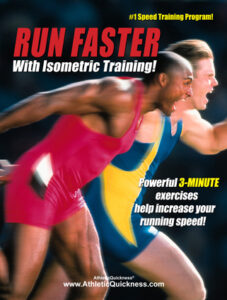This is not the isometric training program your parents were taught
Today’s isometric training is much more than just helping
you get past a sticking point with your bench press.
Whenever you ask someone if they include a form of isometric training in their workout, you rarely find anyone who makes time for it. And, if you are lucky enough to find someone who does apply this strategy, you usually will hear them say that they only use it to help them get past a sticking point in their bench press but not much else.
The Bench Press Sticking Point
What they mean by helping them get past a sticking point is this: Under normal, non- isometric training circumstances while performing a bench press, athletes will lift the bar off the rack, lower it to their chest and press it back up. They do this in one continuous motion and they usually repeat it typically 8-12 times, depending on the amount of weight used as well as their fitness goals.
Athletes will usually know beforehand which position of the bench press exercise they are the weakest. This point, or points, is usually called their sticking point with the exercise, and it is these sticking points that limit the total amount of weight they can press.
If they can just get past these sticking points, they can move on to add more weight. Since most athletes like to ask each other their favorite question, “How much can you bench?” it is for good reason that they will try everything possible to help them improve it so they answer it with confidence. Therefore, this is where athletes are most likely to introduce isometric contractions into their workouts. Unfortunately, it is also where it ends.
Since isometric contractions do not involve any noticeable change in the length of the muscle, but rather a static ‘hold’ position, athletes will typically lower the bar to this sticking point, or raise it back up to this point, and try and hold it there for as long as they can.
The idea is to get to a point of failure with this exercise where they can no longer hold the bar in this position and eventually need to get help from their spotter to place the weight back on the rack.
Below is a snapshot of an isometric contraction or hold during the bench press. The athlete shown lying on the bench has the weight in his hands, and is simply holding it in this position until his strength starts to dissipate. At that point, the spotter probably does a little encouraging for him to hold it for a few more seconds before helping lift the bar back up on the rack.

This is very effective and should be done wherever you think is necessary. It certainly has its place in the fitness world. Used alone, it has limitations for developing better athletes.
[sc name=”2-stepoptin-blue”]
Isometric Training with Weights Vs. Isometric Training with Resistance Bands
So what’s the difference between using weights with an isometric training strategy versus using the resistance band with an isometric training strategy the way our programs teach?
There are several differences; one is the safety with which the resistance band can be used. There are many different positions your body can be placed-in to hold a resistance band with an isometric strategy that doing the same with a static weight wouldn’t always be practical or even possible. Bending and twisting positions while holding a stretched band are less likely to injure you if you lose control of the exercise and have to let go. The same may not always be said with weights.
Another difference is convenience. The bands weigh just a few ounces but can supply upwards of hundreds of pounds of force if several are combined together. You can carry them in your pocket and travel with them to other locations. You don’t have to be restricted to a gym. You can attach them to door frames or bed posts and do many of the same exercises you would do in the gym. Again, the same couldn’t be said with weighted plates or dumbbells.
There are a few other differences, but the one I’m devoting this article to, is the variable amount of resistance the bands can supply versus the static or unchanging amount of resistance weights can supply. More specifically is how this variable versus static difference affects your coordination, balance, speed, strength and ultimately improves your performance in ways that cannot be achieved with one form of resistance alone.
In our bench press example above, the amount of force the weight is offering is the same regardless of where in relation it is to the athlete’s body. This is the case whether the athlete is holding an isometric contraction with the weight in one position or performing a repetition with it where it travels through the full range of motion. It is also the case when the athlete is near failure with the exercise and his muscles start to weaken, shake and give out as the weight eventually overtakes him. In each situation the amount of force supplied by the weight never changes.
If resistance bands were used for this bench press, they would be fastened from the bar to the floor on both sides replacing the weights, and you would have what appears to be two situations:
1) If you were to perform a repetition with the bar, the resistance would vary from very low resistance when the bar was on your chest and the bands hardly stretched to high resistance when bar is pressed back up and the bands are fully stretched.
2) The resistance would remain the same if the bar was held perfectly still in a similar position to the picture shown above.
In the example of the bench press with weights, let’s say the athlete can hold the bar rather steady for about ten seconds, but after that the weight of the bar begins to overpower his muscles. He then tries to muster more strength and his muscles begin recruiting more motor units. He eventually tires, his arms start to shake, elbows begin to flex and, even though he desires to hold the bar perfectly still, he no longer can.
In this situation, with all the small fluctuations in length occurring rapidly in his muscles along with the small changes in the position of his elbows, the weight or force remains the same, never changing.
Even with small changes in arm position while attempting to hold a position, muscle recruitment follows the same patterns as with a normal bench press repetition; they increase on the way up if your arms shift slightly above the sticking point position or decrease on the way down if your arms are lowered slightly below the sticking point.
Dynamic Resistance With Bands Conditions Muscles In Ways That Static Weights Can’t
The same cannot be said while using the resistance band. When your muscles begin to fail under the force of a resistance band is when the biggest value of using a resistance band is revealed.
When your muscles are forced into a weakened state and have to fight to hold a certain position, they begin to shake just as if you were using weights, however, with a variable resistance band, every movement, no matter how small, has a completely different effect on them.
If your arm position goes slightly up even a few millimeters, the resistance level increases. And if your arm position slightly drops a few millimeters, the resistance level decreases. Again, this doesn’t happen with weights. Even if your arms go side to side as you are holding the bar with the bands attached, as you attempt re-establish your center balance, the resistance changes. None of these dynamic changes in resistance occurs with weights.
[sc name=”2step-optin”]
Exposing Muscles To Their Weaknesses
Is the Key To Optimizing Their Conditioning
Many athletes are not prepared for these subtle changes in resistance simply because they have never experienced them before. The coordination of their muscles is initially off balance and an over-stimulation and/or under-stimulation of the fibers is immediately required to readjust to this dynamic change in force.
Attempting to adjust to and quickly correct for the continually changing levels of resistance is when the athlete’s weaknesses and lack of muscle coordination are exposed and can be improved or eliminated.
This exposure of muscle weakness and lack of coordination is what you want from an exercise routine that is designed to help increase your muscles speed and quickness.
You want to introduce as many new and different stimuli as you can to get muscles to initially over-react and/or under-react to the variable resistance and force an instantaneous adjustment to them. See the muscle confusion article for more about this.
Undetected Muscle Weakness and Lack of Coordination Will Prevent Higher Levels of Speed and Performance
By doing these exercises, the weaknesses discovered and then eliminated during the workout session will no longer hamper the athlete’s speed when he is on the field, the track, or on the court, rather the athlete will now be enabled to achieve even higher levels of performance.
For your strength, speed and coordination to remarkably improve, consider introducing the following into your current workout:
1) Put your muscles through ALL three types of contractions: concentric contractions (e.g. weight training), eccentric contractions (e.g. body weight exercises) and isometric contractions using the resistance band.
2) Include training exercises outside your muscles normally conditioned patterns and planes of motion. We used the bench press exercise as our example here. However, performing isometric exercises using the resistance band, with its dynamic resistance properties, in new and different planes and angles, far apart from the guided pathways of a weight machine or other familiar exercise, will expose and correct serious strength, speed and coordination weaknesses in your muscles.
Getting the opportunity to safely and effectively work on eliminating muscle weaknesses and lack of control and coordination will produce dramatic increases in your athletic performance.
It will help you to start developing completely unique neuro-pathways and muscle contraction patterns within your muscles and significantly improve your strength, speed and coordination along the way. The results will be evident in your muscle speed, coordination and strength in any of your sport skills.
[sc name=”runfaster testimonial banner – green”]
[sc name=”Order Here Button-01″]
Always glad to help!
Dr. Larry Van Such







Hi, do you have any kind of affiliate program?